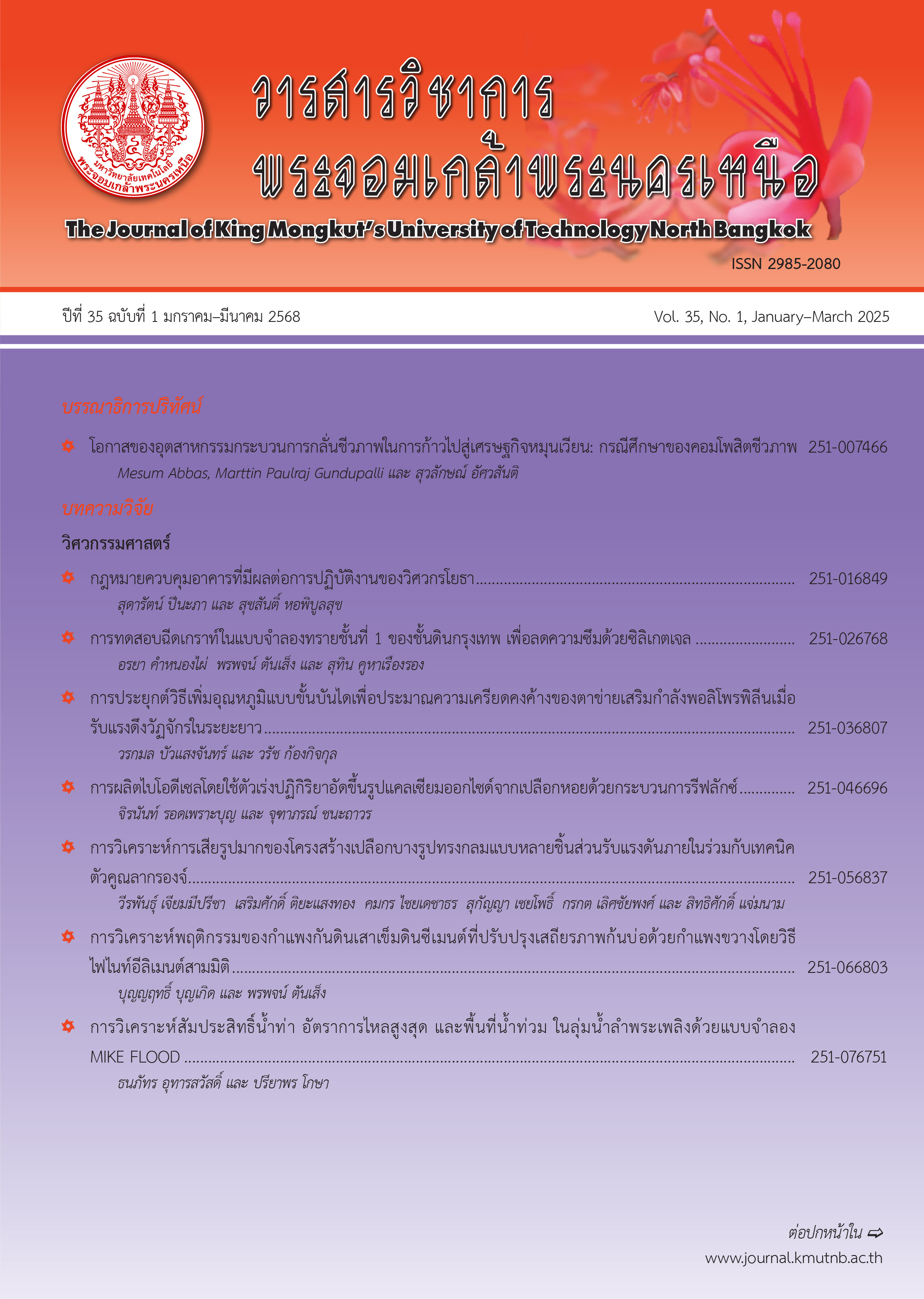Effect of Intermediate Principal Stress on Biaxial Compressive Strength of Rocks
Main Article Content
Abstract
In this study cubical Specimens of nine rock types are subjected to uniaxial and biaxial compression tests using a biaxial loading device. The objective is to determine the effect of intermediate principal stress ( σ2 ) on rock strength. The results indicate that for all tested rocks, σ2 affects the major principal stress at failure. The maximum strengths are obtained at Lode parameter (L) of about –0.5, above and below L = –0.5, the rock strengths decrease. Post-test Specimens under high σ2 show multiple extensile fractures parallel to σ1 – σ2 plane, particularly for strong rocks. Combination of extensile and shear fractures are observed under low σ2 . The modified Wiebols and Cook criterion is adequate to describe the biaxial compressive strengths under all Lode parameters. For all rock types, the elastic moduli and Poisson’s ratios tend to be independent of the intermediate principal stress. The factor of safety (FS) of the biaxial compressive strength is higher than uniaxial compressive strength. Increasing Lode parameter correlates with intermediate principal stress resulting in a higher factor of safety.
Article Details

This work is licensed under a Creative Commons Attribution-NonCommercial-NoDerivatives 4.0 International License.
The articles published are the opinion of the author only. The author is responsible for any legal consequences. That may arise from that article.
References
G. A. Wiebols and N. G. W. Cook, “An energy criterion for the strength of rock in polyaxial compression,” International Journal of Rock Mechanics and Mining Sciences & Geomechanics Abstracts, vol. 5, no. 6, pp. 529–549, 1968.
S. A. F. Murrell, “A criterion for brittle fracture of rocks and concrete under triaxial stress, and the effect of pore pressure on the criterion,” in Proceedings. 5th Symposium on Rock Mechanics, Minnesota, USA, 1963, pp. 563–577.
J. Handin, H. C. Heard, and J. N. Magouirk, “Effects of the intermediate principal stress on the failure of limestone, dolomite, and glass at different temperatures and strain rates,” Journal of Geophysical Research, vol. 72, no. 2, pp. 611–640, 1967.
R. P. Tiwari and K. S. Rao, “Physical modeling of a rock mass under a true triaxial stress state,” International Journal of Rock Mechanics and Mining Sciences, vol. 41, no. 3, pp. 396–401, 2004.
M. Cai, “Influence of intermediate principal stress on rock fracturing and strength near excavation boundaries—insight from numerical modeling,” International Journal of Rock Mechanics and Mining Sciences, vol. 45, no. 5, pp. 763–772, 2008.
E. Sahouryeh, A. V. Dyskin, and L. N. Germanovich, “Crack growth under biaxial compression,” Engineering Fracture Mechanics, vol. 69, no. 18, pp. 2187–2198, 2002.
T. Sriapai, C. Walsri, and K. Fuenkajorn, “Truetriaxial compressive strength of Maha Sarakham Salt,” International Journal of Rock Mechanics and Mining Sciences, vol. 61, pp. 256–265, 2013.
X. Yun, H. S. Mitri, X. Yang, and Y. Wang, “Experimental investigation into biaxial compressive strength of granite,” International Journal of Rock Mechanics and Mining Sciences, vol. 47, no. 2, pp. 334–341, 2010.
B. Haimson and J. W. Rudnicki, “The effect of the intermediate principal stress on fault formation and fault angle in siltstone,” Journal of Structural Geology, vol. 32, no. 11, pp. 1701–1711, 2010.
P. Garg, B. Pandit, and B. Mishra, “Investigation of the failure mode of intact rock in biaxial compression tests,” In 52nd US Rock Mechanics/Geomechanics Symposium. American Rock Mechanics Association. West Virginia University, USA, 2018.
G. A. Wiebols and N. G. W. Cook, “An energy criterion for the strength of rock in polyaxial compression,” International Journal of Rock Mechanics and Mining Sciences & Geomechanics Abstracts, vol. 5, pp. 529–549, 1968.
J. C. Jaeger, C. N. G. W., and R. W. Zimmerman, Fundamentals of Rock Mechanics, 4th ed. Oxford: Blackwell, 2007.
Standard Test Methods for Compressive Strength and Elastic Moduli of Intact Rock Core Specimens under Varying States of Stress and Temperatures, West Conshohocken, Pennsylvania, ASTM D7012-14, 2014.
W. Lode, “Versuche ueber den Einfluss der mittleren Hauptspannung auf das Fliessen der Metalle Eisen Kupfer und Nickel,” Mechanics, vol. 36, no. 11–12, pp. 913–939, 1926.
S. Komenthammasopon and K. Fuenkajorn, “Effects of stress path on biaxial strengths of sandstones.” Engineering Journal of Research and Development, vol 26, no. 2, pp. 49–57, 2015.
C. Chang and B. Haimson, “True triaxial strength and deformability of the German Continental Deep Drilling Program (KTB) deep hole amphibolite,” Journal of Geophysical Research: Solid Earth, vol. 105, no. B8, pp. 18999–19013, 2000.
P. H. Kulatilake, J. Park, and B. Malama, “A new rock mass failure criterion for biaxial loading conditions,” Geotechnical and Geological Engineering, vol. 24, no. 4, pp. 871–888, 2006.
M. H. Mehranpour and P. H. Kulatilake, “Comparison of six major intact rock failure criteria using a particle flow approach under true-triaxial stress condition,” Geomechanics and Geophysics for Geo-Energy and Geo-Resources, vol. 2, no. 4, pp. 203–229, 2016.
H. Zhang, Z. Wan, D. Ma, Y. Zhang, J. Cheng, and Q. Zhang, “Experimental investigation on the strength and failure behavior of coal and synthetic materials under plane-strain biaxial compression,” Energies, vol. 10, no. 4, p. 500, 2017.
K. Artkhonghan, S. Sartkaew, T. Thongprapha, and K. Fuenkajorn, “Effects of stress path on shear strength of a rock salt,” International Journal of Rock Mechanics and Mining Sciences, vol. 104, pp. 78–83, 2018.
S. A. Zhou, “Program to mode the initial shape and extent of borehole break out,” Computers and Geosciences, vol. 20, no. 7–8, pp. 1143–1160, 1994.
K. F. Riley, S. J. Bence, and M. P. Hobson, Mathematical methods for physics and engineering: A comprehensive guide. Cambridge, United Kingdom: Cambridge University Press, pp. 1008, 1998.
B.H.G. Brady and E.T. Brown, Rock Mechanics for Underground Mining, 3rd ed. Dordrecht, Netherlands: Springer, pp. 626, 2006.

